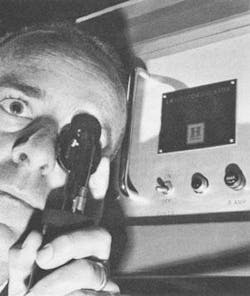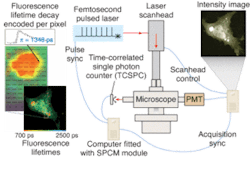‘Lasers to achieve full biomedical potential by 1968’
In the June 1, 1965, issue of Laser Focus the editors published a comprehensive special report on biomedical applications of lasers that had been explored in the five years prior to the magazine’s inaugural issue. The report began as follows:
“Since the first working laser was demonstrated five years ago, medical-technical teams have zealously conceived, developed, and marketed laser instruments such as retinal ‘welders,’ ophthalmoscopes, fiberoptic hypodermic needles, microscopes, spectrometers, and therapeutic irradiators (see “Retinal welding leads the way”). They have also used the laser as a tool to discover new things about biological systems and to investigate the effects of laser radiation.
“If the agendas of recent scientific and technological meetings are any criteria, laser biomedical applications are becoming an increasingly significant area of activity. In some instances, half of the laser sessions were devoted to research on, development of, and clinical experimentation with lasers in medicine and biology.
“Consensus of opinion at these meetings seemed to be that lasers will make a significant contribution to biomedicine, but up to three years of development probably will be required to realize the full potential of the device [italics added]. According to most experts, the important first step toward widespread clinical use of the laser is a method for precisely measuring a laser’s output.”
Of course, 40 years later, the full potential of lasers in medicine has yet to be developed, in part because continuing technological developments have continued to expand their potential. Beginning in the 1969-1970 time frame, laser manufacturers started to shift focus toward developing laser systems for civilian applications such as medicine, motivated in part by shrinking percentages of defense vs. total spending in the laser market (as reported in Laser Focus) from 63.4% in 1969 to 58% in 1970 and 55% in 1971.
In the mid-1980s, Kathy Kincade, now a contributing editor with Laser Focus World, inaugurated the Medical Laser Report newsletter to cover business, clinical, and technology trends in the medical-laser industry. In the October 1998 issue of Laser Focus World, the first “Medicalwatch” column appeared in the magazine, projecting 19% growth in the surgical laser market in 1998 due in large part to strong markets for dermatology and plastic surgery procedures such as skin resurfacing and hair removal; ophthalmology procedures such as photorefractive keratectomy (PRK) and laser-assisted in situ keratomileusis (LASIK); and cardiology procedures such as transmyocardial revascularization (TMR).
“Newer laser technologies are also having an impact on the medical-laser market,” according to the same article. “The erbium-doped YAG (Er:YAG) laser emitting at 2.94 µm is gaining favor for a variety of applications in dermatology, ophthalmology, and dentistry. In addition, ongoing refinement of diode-laser technology is prompting broader use of these devices for applications ranging from hair and leg-vein removal to tissue welding and optical diagnostics. In fact, this technology is helping to accelerate the development of laser-based diagnostic products for such applications as optical biopsies and tumor detection, and sales of diagnostic-laser devices are expected to reach $150 million in 1998.”
In 2004, cosmetic surgery and ophthalmology continued as prime movers in a $2.4 billion global market for medical-laser systems, projected to hit $2.7 million in 2005 (see Laser Focus World January 2005, p. 95). But the real impact of lasers on surgery may be just beginning, as the development and commercialization of femtosecond lasers has enabled far more precise cutting than their nanosecond predecessors because of photodisruption on the femtosecond timescale, in which an extremely high electric field tears atoms apart, producing a highly localized plasma and minimal disruption to surrounding tissues. So a 500-fs laser pulse will create a tissue cavity that is only 3 to 13 µm across, while the photoablation or tissue vaporization of a 10-ns laser pulse will use 100 times as much fluence to create a tissue cavity 100 times as large (see Laser Focus World, September 2002, p. 99).
Even as technical innovations in lasers continue to push the realization of their full potential in medicine well beyond the three-year estimate published in Laser Focus 40 years ago, the subsequent editorial comment in the same paragraph, about precise measurement as a first step, seems to become even more prescient with time. Under the subhead “Measurement and Visualization” in their June 1965 special report, the Laser Focus editors wrote: “As a single source of coherent light in interference microscopy, laser could well make conventional sources obsolete. Also laser can be used to measure incredibly small movements of biophysical significance because of the constancy of frequency of the emitted light.”
Almost 40 years later, a special report by Laser Focus World editors began with essentially the same ideas clothed in the specifics of the day: “Biomedical optical-imaging technology is achieving unprecedented spatial resolution (on the order of a few microns in the case of optical coherence tomography), centimeters of subsurface penetration using near-infrared wavelengths in the case of diffuse optical tomography, as well as wider ranges of functional information based on a variety of methods that include Doppler techniques and the use of fluorescent and phosphorescent markers” (see Laser Focus World, March 2004).The upshot of all of this is that lasers and optics haven’t reached their full potential in medicine during the last 40 years, because at the same time as advances in laser science, technology, and commercially available systems have been improving the capabilities of conventional medicine, they have also been enabling a totally new approach to medicine that is no longer limited to working with anatomy at the level of organs, but is now working with functional physiology at the cellular level (see Fig. 2). And of course emerging nanophotonics technologies promise medical imaging and treatment capabilities on the molecular level. Considering the foregoing, perhaps the only definite statement one can make at this point is that the laser will definitely not achieve its full biomedical potential within the next three years.
Retinal welding leads the way
Lasers found their first intensive and successful medical application in treating retinal disorders, according to Joan Lisa Bromberg (The Laser in America, 1950-1970, The MIT Press, 1991, p. 244). As early as 1961, a pulsed ruby laser was used for experimental photocoagulation (also known as “retinal welding”). An applications article in the Jan.15, 1965, issue of Laser Focus described a flashlamp-pumped, 0.1-J, 6943-angstrom, laser retinal photocoagulator undergoing tests at the Mayo Clinic:
“During the latter part of 1964, Honeywell’s Ordnance Division delivered to the Mayo Clinic in Rochester, Minn., an ultra-accurate, handheld laser photocoagulator. Doctors at Mayo have made exceptionally rapid progress in their experimental use of the instrument on animals and have recently begun limited testing on damaged human retinas. Primary aim of the studies is to correlate beam energy levels with varying pigmentation characteristics of retinas.
“For several years ophthalmologists have performed retinal operations using bulky arc-lamp systems that required a long set-up time and the use of an anesthesia. Subsequent development of laser photocoagulators provided these doctors with a quicker, painless way of doing the same thing. The new device (see Fig. 1) incorporates all of these advantages plus what Honeywell contends is an important unique feature-it can be much more accurately aimed than can other laser or nonlaser instruments currently in use.”
Inside Laser Focus: July 1965
- Parley sheds light on future biomedical lasers
- Laser interferometer system detects surface contour deviations
- ‘Flowing-gas’ laser achieves high efficiency, high-power output
- Multifrequency coherent oscillator uses laser pump
- Arc-striking by laser demonstrated
- New models of laser rangefinders announced
- Maiman receives medal
- Two more roads opened for laser progress
- The laser as a machining and welding tool
- Laser polarimeter checks hull alignment
- Lasers play role in night photography
- Surveillance laser radar scheduled for installation
- Amplification of laser light
- MHD-powered lasers under study

